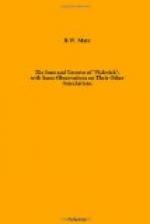To have the distinction of being the venue for such notable events is something that any self-respecting hotel should be proud of, and we are sure that Osborne’s Hotel will be remembered so long as it stands for those reasons alone. But it has other reasons for fame, even if they are more likely to be forgotten, or lightly passed over by those who keep the records of London’s notable landmarks. It stands to-day in a neighbourhood distinguished for its history, and has claims to a share in the making of that history.
It is situated, as it has always been, at the corner of John and Adam Streets, and was first opened in 1777 as the Adelphi New Tavern and Coffee House. Dickens no doubt knew it well, for the Adelphi and its neighbourhood attracted him greatly, and its curious old buildings, side streets and rambling arches often figure in his books. When a mere boy at work in the blacking factory, down by the river there, he continually wandered about its quaint byways. “Osborne’s” was a notable house in those days, and if its full records were available, no doubt many an entertaining story concerning its activities could be told. As it is, it is known that “being completely fitted up in the most elegant and convenient manner for the entertainment of noblemen and gentlemen,” as it boasted in its early days, many notable figures in past history made it their headquarters.
On the 8th August, 1787, Gibbon stayed there on his arrival from Lausanne with the completion of his “History,” and wrote to Lord Sheffield to apprise him of the fact. In 1802 Isaac D’Israeli, the author of Curiosities of Literature and father of the famous Earl of Beaconsfield, stayed in the hotel after his honeymoon. It is also on record that George Crabbe, the poet, with his wife resided for a time there, and that Rowlandson, the caricaturist, died in one of its rooms in 1827.
Perhaps the most notorious of visitors to it were the King and Queen of the Sandwich Islands in 1824. Unfortunately, both were victims to the smallpox epidemic which raged at the time, and died in the hotel, the latter on the 8th July of that year and the former on the 14th September. The visit of the “illustrious” king, we are told, gave rise to the popular song, “The King of the Cannibal Islands.”
During the war it was acquired as a house of utility for the military. Before it was acquired for that purpose it was the favoured resort of business men of the neighbourhood and of certain literary and artistic coteries, and was the headquarters of the famous O.P. Club. However, it has returned now to its old-time ways and methods, and we hope it will long remain a landmark for the Dickens lover and particularly the Pickwickian devotee.




